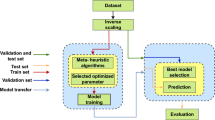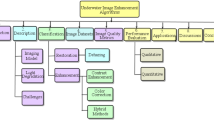Abstract
This study aims to develop methods that are capable of deciding the breaking criterion for an internal solitary wave (ISW) propagating over a submarine ridge. Laboratory experiments were conducted in a wave tank to measure ISWs propagating over a submarine ridge. The results suggest that the ISW-ridge interaction can be grouped according to three degrees of magnitude based on the blockage parameter ζ and the degree of blocking B. For classification reasons, we first present an alternative decision model for evaluating the interaction of ISWs with an underwater ridge in a two-layer system. This approach is based on a multivariate statistical method and discriminant analysis. Information obtained from the eigenvalues is used to combine different ratio measures which are defined according to every single input and output. The discriminant model effectively classifies units into distinct predefined groups. An experimental simulation is conducted to demonstrate the practical implementation of the ISW-ridge interaction. The results of the method applied in this example are statistically significant, demonstrating the effectiveness of the ISW-ridge interaction classification method.
Similar content being viewed by others
References
Bole JB, Ebbesmeyer JJ, Romea RD (1994) Soliton currents in South China Sea: measurements and theoretical modelling. In: Proc. 26th Annual Offshore Tech. Conf. Houston, Texas, pp 367–375
Bourgault D, Kelley DE (2003) Wave-induced boundary mixing in a partially mixed estuary. J Mar Res 61: 553–576
Cacchione DA, Pratson LF, Ogston AS (2002) The shaping of continental slopes by internal tides. Science 296: 724–727
Chen CY (2007) An experimental study of stratified mixing caused by internal solitary waves in a two-layered fluid system over variable seabed topography. Ocean Eng 34(14–15): 1995–2008
Chen CY, Hsu JRC (2005) Interaction between internal waves and an impermeable seabed. Ocean Eng 32(5-6): 587–621
Chen CY, Hsu JRC, Chen CW, Cheng MH (2006) Numerical model of an internal solitary wave evolution on impermeable variable seabed in a stratified two-layer fluid system. China Ocean Eng 20(2): 303–313
Chen CY, Hsu JRC, Cheng MH, Chen HH, Kuo CF (2007) An investigation on internal solitary waves in a two-layer fluid: propagation and reflection from steep slopes. Ocean Eng 34(1): 171–184
Chen CW, Chen CY, Yang PHC, Chen TH (2007) Analysis of experimental data on internal waves with statistical method. Eng Comput 24(2): 116–150
Chen CY, Chen CW, Tseng IF (2007) Localised mixing due to an interfacial solitary wave breaking on seabed topography in different ridge heights. J Offshore Mech Arct Eng, ASME 129(3): 245–250
Chen CY, Hsu JRC, Chen CW, Chen HH, Kuo CF, Cheng MH (2007) Generation of internal solitary wave by gravity collapses. J Mar Sci Technol 15(1): 1–7
Chen CY, Hsu JRC, Chen CW, Kuo CF, Chen HH, Cheng MH (2007) Wave propagation at the interface of a two-layer system in the laboratory. J Mar Sci Technol 15(1): 8–16
Chen CW, Yang PHC, Chen CY, Chang AKH, Chen TH (2008) Evaluation of inference adequacy in cumulative logistic regression models: an empirical validation of ISW-ridge relationships. China Ocean Eng 22(1): 43–56
Chen CY, Yang PHC, Chen CW, Chen TH (2008) Diagnosing and revising logistic regression models: effect on internal solitary wave propagation. Eng Comput 25(2): 121–139
Chen TH, Chen CY, Yang PHC, Chen CY (2008) Mathematical tool for inference in logistic regression with small-sized data sets—a practical application on ISW-ridge relationships. Math Probl Eng. Article ID 186372. doi:10.1155/2008/186372
Chen CY, Hsu JRC, Cheng MH, Chen CW (2008) Experiments on mixing and dissipation in internal solitary waves over two triangular obstacles. Environ Fluid Mech 8(3): 199–214
Cheng MH, Hsu JRC, Chen CY, Chen CW (2008) Modeling internal solitary wave across double ridges and a shelf-slope. Environ Fluid Mech 9(3): 321–340
Corredor JE (2008) Development and propagation of internal waves in the Mona Passage. Sea Technol 49(10): 48–50
Díaz-flores EJF, Díaz-flores EF, Hernandez CC, Rodriguez REM, Diaz RC, Serra-majem L (2004) Application of linear discriminant analysis to the biochemical and haematological differentiation of opiate addicts from healthy subjects: a case–control study. Eur J Clin Nutr 58: 449–455
Dyszel SM (1996) Country of origin of peanuts: a comparison of statistical software for discriminant analysis of DSC results. Thermochim Acta 284(1): 103–108
Egan WJ, Morgan SR, Bartick EG, Merrill RA, Taylor HJ (2003) Forensic discrimination of photocopy and printer toners II. Discriminant analysis applied to infrared reflection-absorption spectroscopy. Anal Bioanal Chem 376(8): 1279–1285
Guo YK, Sveen JK, Davies PA et al (2004) Modelling the motion of an internal solitary wave over a bottom ridge in a stratified fluid. Environ Fluid Mech 4(4): 415–441
Hair JF, Black WC, Babin BJ, Anderson RE, Tatham RL (2006) Multivariate data analysis (6 edn). Prentice Hall, New Jesrsey
Helfrich KR (1992) Internal solitary wave breaking and run-up on a uniform slope. J Fluid Mech 243: 133–154
Kao TW, Pan FS, Renouard D (1985) Internal solitions on the pycnocline: generation, propagation, shoaling and breaking over a slope. J Fluid Mech 159: 19–53
Klymak JM, Moum JN (2003) Internal solitary waves of elevation advancing on a shoaling shelf. Geophys Res Lett 30: 2045. doi:10.1029/2003GL017706
Michallet H, Ivey GH (1999) Experiments on mixing due to internal solitary waves breaking on uniform slopes. J Geophys Res 104(C6): 13467–13477
Moore SE, Lien RC (2007) Pilot whales follow internal solitary waves in the South China Sea. Mar Mamm Sci 23(1): 193–196
Moum JN, Farmer DM, Smyth WD, Armi L, Vagle S (2003) Structure and generation of turbulence at interfaces strained by internal solitary waves propagating shoreward over the continental shelf. J Phys Oceanogr 33: 2093–2112
Sharma S (1996) Applied multivariate techniques. Wiley, pp 237–316
Stevick PT, Incze LS, Kraus SD, Rosen S, Wolff N, Baukus A (2008) Trophic relationships and oceanography on and around a small offshore bank. Mar Ecol Prog Ser 363: 15–28
Sveen JK, Guo Y, Davies PA, Grue J (2002) On the breaking of internal solitary waves at a ridge. J Fluid Mech 469(25): 161–188
Wang YH, Dai CF, Chen YY (2007) The physical and ecological processes of internal waves on an isolated reef ecosystem in the South China Sea. Geophys Res Lett 34: L18609. doi:10.1029/2007GL030658
Wessels F, Hutter K (1996) Interaction of internal waves with a topographic sill in a two-layered fluid. J Phys Oceanogr 26(1): 5–20
Zheng Q, Susanto RD, Ho CR, Song YT, Xu Q (2007) Statistical and dynamical analyses of generation mechanisms of solitary internal waves in the northern South China Sea. J Geophys Res-Oceans 112. doi:10.1029/2006JC003551
Author information
Authors and Affiliations
Corresponding author
Rights and permissions
About this article
Cite this article
Chen, CY. Using discriminant analysis to determine the breaking criterion for an ISW propagating over a ridge. Environ Fluid Mech 10, 577–586 (2010). https://doi.org/10.1007/s10652-010-9172-1
Received:
Accepted:
Published:
Issue Date:
DOI: https://doi.org/10.1007/s10652-010-9172-1




